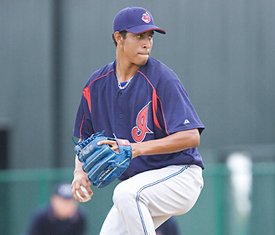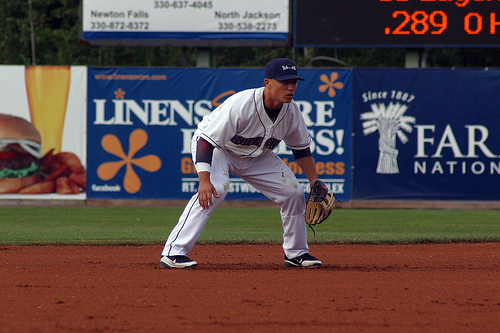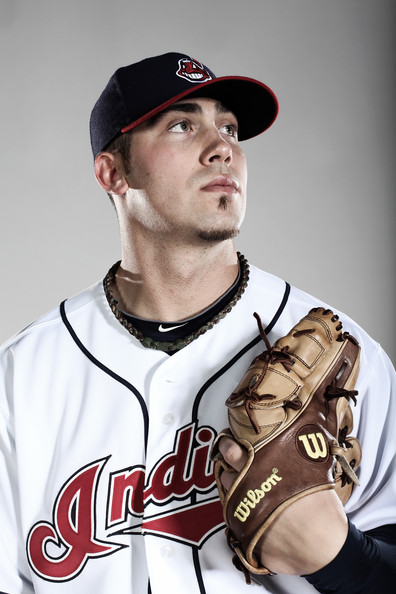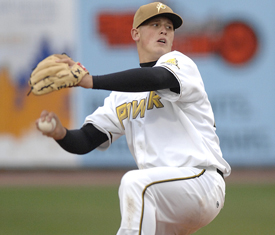 Indians Archive
Indians Archive  Cleveland Indians Top 50 Prospects: #11-15
Cleveland Indians Top 50 Prospects: #11-15
 Now we're really starting to get into the creme de la creme of the system. Or as it's known around Cleveland these days, the power bullpen arms. Four of these next five are power righthanded arms that will likely spend their entire careers in the bullpen. I know what some of you must be thinking right now. 'What about Chun Chen? Did he forget about Chen?' Answer: no, Chen is still to come on our countdown (I really like him). 'What about Adam Miller? Is he still in the top 10?' Answer: awww, bless your ever-optimistic heart. If you're really waiting for Atom Miller to make his appearance on this list, you'll have to be satisfied with a different power righthander who has had recent injury issues instead.
Now we're really starting to get into the creme de la creme of the system. Or as it's known around Cleveland these days, the power bullpen arms. Four of these next five are power righthanded arms that will likely spend their entire careers in the bullpen. I know what some of you must be thinking right now. 'What about Chun Chen? Did he forget about Chen?' Answer: no, Chen is still to come on our countdown (I really like him). 'What about Adam Miller? Is he still in the top 10?' Answer: awww, bless your ever-optimistic heart. If you're really waiting for Atom Miller to make his appearance on this list, you'll have to be satisfied with a different power righthander who has had recent injury issues instead.
In case you missed any of our series, here's links to prospects #41-50, #31-40, #21-30 and #16-20.
15. Hector Rondon, RHP
DOB: 02/26/1988
Height/Weight: 6-3/180
Bats/throws: R/R
Acquired: International FA in 2004
2010 Stats: 1-3, 8.53 ERA, 33 K and 10 BB in 31 2/3 IP for AAA Columbus
 Scouting report: Hector Rondon is a guy that I was never quite as high on as most scouts and pundits. He has an electric fastball that he can spot pretty much at will. He challenges hitters with the pitch, and rarely walks guys. The pitch sits between 93-95 MPH, and can touch 97. In addition to the fastball, he has an above-average changeup that plays up due to his effectiveness with the fastball. He is also working on a slider, but the pitch isn’t where it needs to be and he really relies on just two pitches to get hitters out. If he wants to start in the major leagues, he’ll need a breaking pitch of some sort, as even with as good as his fastball is, he can’t rely on it exclusively as a starter. He’s got a ton of talent, but without that third pitch I don’t see him as more than a reliever in the major leagues. I’m of the opinion that the Indians should just move him to the bullpen and get him some meaningful innings in the big leagues rather than continue to develop him as a starting pitcher.
Scouting report: Hector Rondon is a guy that I was never quite as high on as most scouts and pundits. He has an electric fastball that he can spot pretty much at will. He challenges hitters with the pitch, and rarely walks guys. The pitch sits between 93-95 MPH, and can touch 97. In addition to the fastball, he has an above-average changeup that plays up due to his effectiveness with the fastball. He is also working on a slider, but the pitch isn’t where it needs to be and he really relies on just two pitches to get hitters out. If he wants to start in the major leagues, he’ll need a breaking pitch of some sort, as even with as good as his fastball is, he can’t rely on it exclusively as a starter. He’s got a ton of talent, but without that third pitch I don’t see him as more than a reliever in the major leagues. I’m of the opinion that the Indians should just move him to the bullpen and get him some meaningful innings in the big leagues rather than continue to develop him as a starting pitcher.
Rondon struggled out of the gate in 2010 in AAA Columbus, and then went down with an elbow injury that cost him the remainder of the season and required Tommy John surgery to repair. He tried to rehab the injury and return to throwing, but the rehab didn’t take and he ended up going under the knife in August. If he pitches in 2011, it will likely be in the complex leagues or in Arizona after the 2011 regular season is complete.
Glass half-full: Rondon comes back healthy, develops a breaking ball, proves me wrong and sticks in the rotation.
Glass half-empty: He struggles to return from surgery, never develops an effective 3rd pitch and ends up in the bullpen.
14. Tony Wolters, SS
DOB: 6/9/1992
Height/Weight: 5-10/165
Bats/Throws: L/R
Acquired: 3rd round pick in 2010
2010 Stats: .211/.286/.211 with 0/3 and 2 SB in 19 AB for Rookie AZL Indians
Scouting report: Drafted out of high school, Wolters doesn’t have any one single skill that jumps out at you, but the more you look at his game the more you realize he doesn’t have any real weaknesses either. He’s a plus defender at SS, with an extremely strong arm. He’s a little bit undersized, and because of that and his grinder attitude he’s drawn some comparisons to Dustin Pedroia. Nearly every scouting report you read on Wolters uses the term “baseball rat” as he’s a guy that just loves playing the game, and it shows up on the field. He has good speed on the bases, and is an excellent baserunner. He does a great job of squaring up on the baseball, and always seems to get the barrel of the bat on the ball. He doesn’t have a ton of pop, but should develop double-digit HR power as he matures. Wolters was on the U18 Team USA squad that won the gold over Cuba at the Pan Am Junior Games. He was considered one of the top high school position players in the draft, and a consensus top-100 guy overall that the Indians were able to snag with the 87th overall pick and lure away from a full ride to San Diego State with an overslot signing bonus.
realize he doesn’t have any real weaknesses either. He’s a plus defender at SS, with an extremely strong arm. He’s a little bit undersized, and because of that and his grinder attitude he’s drawn some comparisons to Dustin Pedroia. Nearly every scouting report you read on Wolters uses the term “baseball rat” as he’s a guy that just loves playing the game, and it shows up on the field. He has good speed on the bases, and is an excellent baserunner. He does a great job of squaring up on the baseball, and always seems to get the barrel of the bat on the ball. He doesn’t have a ton of pop, but should develop double-digit HR power as he matures. Wolters was on the U18 Team USA squad that won the gold over Cuba at the Pan Am Junior Games. He was considered one of the top high school position players in the draft, and a consensus top-100 guy overall that the Indians were able to snag with the 87th overall pick and lure away from a full ride to San Diego State with an overslot signing bonus.
Wolters will be just 19 for most of the 2011 baseball season, so there’s really no reason to rush him. Depending on how things go in Goodyear, Wolters will either start 2011 in extended spring training or as the SS for low A Lake County. Either way, he’ll be a fun guy to watch and see how he progresses through the system.
Glass half-full: Wolters sticks at SS, puts on some size and becomes a plus defender and classic #2 hitter
Glass half-empty: Wolters size and strength becomess an issue and he is forced to 2B and his bat never matures to the point that he becomes more than Jamey Carroll in the show.
13. Zach Putnam
DOB: 07/03/1987
Height/Weight: 6-2/225
Bats/throws: R/R
Acquired: 5th round pick in 2008
2010 Stats: 4-2, 3 SV, 3.69 ERA, 65 K and 16 BB in 75 2/3 IP between AA and AAA
 Scouting report: Putnam is a big, strong, athletic pitcher. Drafted out of the University of Michigan, Putnam played 3B and DH in addition to pitching for the Wolverines, and some teams were looking at him as a hitter and not just a pitcher. Ultimately, the Indians took him in the 5th round and paid him overslot money to concentrate on pitching. This means that prior to his professional debut in 2008 with the Scrappers, Putnam never exclusively focused his practice time on improving himself on the mound, as he would still hit and field with the position players in addition to working with his pitching coach. Putnam therefore came to Cleveland a little more raw and with a little more upside and room to grow that most collegiate pitchers. Putnam is a confident pitcher who loves to attack hitters, and has a closer’s mentality whether he pitches the 9th inning or not.
Scouting report: Putnam is a big, strong, athletic pitcher. Drafted out of the University of Michigan, Putnam played 3B and DH in addition to pitching for the Wolverines, and some teams were looking at him as a hitter and not just a pitcher. Ultimately, the Indians took him in the 5th round and paid him overslot money to concentrate on pitching. This means that prior to his professional debut in 2008 with the Scrappers, Putnam never exclusively focused his practice time on improving himself on the mound, as he would still hit and field with the position players in addition to working with his pitching coach. Putnam therefore came to Cleveland a little more raw and with a little more upside and room to grow that most collegiate pitchers. Putnam is a confident pitcher who loves to attack hitters, and has a closer’s mentality whether he pitches the 9th inning or not.
Putnam has a fastball that sits consistently in the 92-94 MPH range, and he can reach back and touch 96. It has decent movement, and helps Putnam induce a lot of groundballs. Putnam has a starter’s arsenal, as he throws a plus splitter, a slider and a changeup in addition to his fastball. The splitter is his out pitch, as most hitters either swing and miss or beat it into the ground. His slider is still a work in progress, but has flashed plus and could be the key to him becoming a dominant reliever. The changeup at this point is not considered a plus pitch, and is used more to keep hitters honest and to change speeds. The four-pitch mix is devastating out of the bullpen, and Putnam has shown to be extremely effective in short outings. The Indians toyed with the idea of keeping him in the starting rotation, but he made the transition to the bullpen full-time in 2010.
Putnam should start 2011 in AAA Columbus, and he will be battling with bullpen mates Bryce Stowell and Vinnie Pestano for a spot in Cleveland. I have a feeling that Cleveland fans will overlook the fact that he went to the school up North once he starts recording outs at the corner of Carnegie and Ontario.
Glass half-full: Putnam refines his slider and becomes a dominant, Betancourt-type arm in the back end of the MLB bullpen.
Glass half-empty: It would be a surprise if Putnam were not at least an average reliever in Cleveland at some point in the next two years.
12. Rob Bryson, RHP
DOB: 12/11/1987
Height/Weight: 6-1/200
Bats/throws: R/R
Acquired: As part of the C.C. Sabathia trade. 31st round pick of the Brewers in 2006.
2010 Stats: 7-2, 2.53 ERA, 80 K and 21 BB in 50 1/3 IP between low A and AA
Scouting report: Bryson was acquired as part of the C.C. Sabathia blockbuster in 2008, and he’s the only player the Indians received that has yet to see the majors. Bryson will play 2011 at age 23, and has seen success at the AA level so he’s on a pretty good timetable. All this despite missing part of 2008 and nearly all of 2009 after having shoulder surgery to repair tears in his labrum and rotator cuff. He pitched just 3 innings for the AZL Indians in 2009, so it was basically a lost season. Bryson’s calling card is his fastball, which sits comfortably in the mid-90s and can touch as high as 97. That’s some serious heat from the right side, especially after the shoulder issues. He compliments his heat with a wipeout slider that is a plus-plus pitch and generates a LOT of swings and misses. He throws a changeup as well, but really just uses it to keep hitters honest as a slower pitch, complimenting his faster offerings.
majors. Bryson will play 2011 at age 23, and has seen success at the AA level so he’s on a pretty good timetable. All this despite missing part of 2008 and nearly all of 2009 after having shoulder surgery to repair tears in his labrum and rotator cuff. He pitched just 3 innings for the AZL Indians in 2009, so it was basically a lost season. Bryson’s calling card is his fastball, which sits comfortably in the mid-90s and can touch as high as 97. That’s some serious heat from the right side, especially after the shoulder issues. He compliments his heat with a wipeout slider that is a plus-plus pitch and generates a LOT of swings and misses. He throws a changeup as well, but really just uses it to keep hitters honest as a slower pitch, complimenting his faster offerings.
Bryson has a clean, easily repeatable delivery that utilizes his thick lower half and helps generate his outstanding arm speed. His motion was a little jerky prior to his injury, and Milwaukee cleaned it up to try and both refine his command and keep him healthy. He has much better command now, as evidenced by his nearly 4/1 K/BB ratio in 2010, especially impressive considering he was still building back arm strength after his surgery. He began the season for low A Lake County, and worked his way all the way up to Akron before the end of the year.
The key to Bryson becoming a dominant 8th/9th inning guy will be the continued development of his changeup. He could post a K/9 rate of over 17 in Kinston with just his fastball and slider, but if he expects to dominate major league hitters in a similar fashion, he will need to be able to change speeds on occasion. The changeup doesn’t have to be a plus offering, but he at least needs to be able to keep hitters honest.
Bryson will probably begin 2011 in the bullpen at AA Akron, but should be in Columbus before too long, and I wouldn’t be at all surprised to see him in Cleveland in 2011. He’s not on the 40-man roster right now, but there will likely be a decent amount of turnover on the 40-man this year with it being a rebuilding year for the Indians.
Glass half-full: He becomes a lights-out setup man, possibly even a closer and strikes out more than a batter per inning.
Glass half-empty: He becomes a good setup man, and pitches the 7th inning for a big league club.
11. Bryce Stowell, RHP
DOB: 9/23/1986
Height/Weight: 6-2/205
Bats/throws: R/R
Acquired: 22nd round pick in 2008
2010 Stats: 3-1, 7 SV, 2.14 ERA, 102 K and 36 BB in 67 1/3 IP between high A and AAA
 Scouting report: Stowell was an overslot singing out of the 22nd round in 2008, but even the Indians didn’t expect him to be as dominant as he was out of the bullpen last year. His best offering is a fastball that can touch triple digits and can just blow hitters away. The fastball picked up a couple of MPH from 2009 to 2010 because Stowell really worked on cleaning up his delivery and making it more repeatable. The work paid off, as his K/9 went up and his BB/9 in A and AA went way down. In addition to the dominant fastball, Stowell throws a slider and a changeup that both made strides towards becoming effective secondary pitches in 2010.
Scouting report: Stowell was an overslot singing out of the 22nd round in 2008, but even the Indians didn’t expect him to be as dominant as he was out of the bullpen last year. His best offering is a fastball that can touch triple digits and can just blow hitters away. The fastball picked up a couple of MPH from 2009 to 2010 because Stowell really worked on cleaning up his delivery and making it more repeatable. The work paid off, as his K/9 went up and his BB/9 in A and AA went way down. In addition to the dominant fastball, Stowell throws a slider and a changeup that both made strides towards becoming effective secondary pitches in 2010.
Stowell had a great 2010 no matter how you look at it, but it was at AA Akron where he was simply untouchable. After showing the Indians that the high A Carolina League wasn’t going to be much of a challenge, Stowell was moved up to the AA Eastern League to face some of the best hitting prospects in baseball. In 14 AA appearances spanning 22 1/3 innings, Stowell did not give up an earned run. He struck out 33, walked 11 and gave up 15 hits for the Aeros. This performance earned him a ticket to AAA Columbus, where he proved that he was mortal, giving up 12 ER in 19 2/3 innings, but still struck out 28 AAA hitters.
Stowell was shut down in late-August last year with some elbow soreness, but it was more of a precautionary move than anything and he didn’t require any sort of offseason surgery to get him ready for 2011. He completed his offseason throwing program in Arizona with no setbacks, and will report to spring training with no restrictions. He will get a shot at making the big club out of Goodyear as a bullpen arm, but will most likely begin at AAA Columbus. Barring injury though, we’ll see Stowell pitching out of the bullpen at Progressive Field at some point in 2011.
Glass half-full: If he stays healthy, Stowell has closer-type stuff and could be a dominating setup man in front of Chris Perez in the 8th inning.
Glass half-empty: Stowell struggles with injury and control and never makes an impact at the big league level.
For the latest and greatest in Indians propsect news, follow me on Twitter: @alciammaichella.
- NBA Announces 2013-2014 Schedule
- Browns Ink Sharknado
- Sharknado A No-Show For Rookie Camp
- Trent Richardson Out Until Training Camp
- Browns Sign Brandon Jackson
- Carrasco Suspended Eight Games
- Browns Add to Wide Receiver Depth with David Nelson
- Browns Need to Learn from Past Draft Mistakes
- Browns Release Chris Gocong and Usama Young
- Browns Missing on Grimes Disappointing, But Not The End
The TCF Forums
- Chris Grant's first 3 drafts
Kingpin74 (Tuesday, January 21 2014 10:13 AM) - The 2014 Offseason Thread
googleeph2 (Tuesday, January 21 2014 9:36 AM) - 2015 Recruiting
furls (Tuesday, January 21 2014 6:57 AM) - Mike Brown
YahooFanChicago (Monday, January 20 2014 11:15 PM) - Movies coming out
HoodooMan (Monday, January 20 2014 9:34 PM) - 2014 Hoops Hockey Hijinx
jpd1224 (Monday, January 20 2014 4:44 PM) - 2014 Recruiting
jclvd_23 (Monday, January 20 2014 2:26 PM) - Wish List - #4 Pick
Hikohadon (Monday, January 20 2014 1:26 PM) - Official- Browns Coach Search/Rumors
OldDawg (Sunday, January 19 2014 6:48 PM) - #1 overall pick Anthony Bennett
TouchEmAllTime (Sunday, January 19 2014 1:28 PM)



